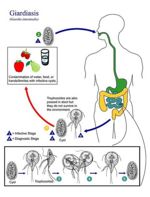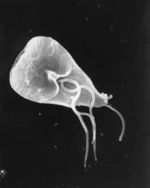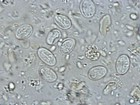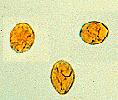Difference between revisions of "Giardia"
Jump to navigation
Jump to search
| (18 intermediate revisions by 4 users not shown) | |||
| Line 1: | Line 1: | ||
| − | {{ | + | {{review}} |
| − | + | ||
| − | + | {{toplink | |
| − | + | |backcolour = | |
| − | + | |linkpage =Parasites | |
| − | + | |linktext =PARASITES | |
| − | + | |pagetype=Bugs | |
| − | + | |sublink1=Protozoa | |
| − | + | |subtext1=PROTOZOA | |
| − | |||
| − | | | ||
| − | | | ||
| − | | | ||
| − | | | ||
| − | | | ||
| − | | | ||
}} | }} | ||
| − | [[Image:Giardia lamblia life cycle.jpg|thumb|right|150px|''Giardia lamblia life cycle | + | <br> |
| + | ==Recognition== | ||
| + | [[Image:Giardia cysts.jpg|thumb|right|150px|''Giardia'' cysts from gerbil faecea - H.D.A. Lindquist, U.S. EPA]] | ||
| + | [[Image:Giardia lamblia life cycle.jpg|thumb|right|150px|''Giardia lamblia'' life cycle - Wikimedia Commons]] | ||
[[Image:Giardia lamblia.jpg|thumb|right|150px|''Giardia lamblia'' - Janice Carr]] | [[Image:Giardia lamblia.jpg|thumb|right|150px|''Giardia lamblia'' - Janice Carr]] | ||
[[Image:Giardia.jpg|thumb|right|150px|''Giardia'' - Joaquim Castellà Veterinary Parasitology Universitat Autònoma de Barcelona]] | [[Image:Giardia.jpg|thumb|right|150px|''Giardia'' - Joaquim Castellà Veterinary Parasitology Universitat Autònoma de Barcelona]] | ||
[[Image:Giardia cyst.jpg|thumb|right|150px|''Giardia'' cyst - Courtesy of the Laboratory of Parasitology, University of Pennsylvania School of Veterinary Medicine]] | [[Image:Giardia cyst.jpg|thumb|right|150px|''Giardia'' cyst - Courtesy of the Laboratory of Parasitology, University of Pennsylvania School of Veterinary Medicine]] | ||
| − | + | *Flagellate protozoa | |
| − | |||
| − | + | *Found in the intestine of humans | |
| + | |||
| + | *Associated with chronic [[Intestine Diarrhoea - Pathology|diarrhoea]] | ||
| + | |||
| + | *Found in both wild and domestic animals | ||
| + | |||
| + | *15-20μm long | ||
| − | + | *Pear-shaped | |
| − | + | *8 flagella | |
| + | **6 flagellae are free | ||
| + | *Large adhesive discs to hold onto intestinal mucosa | ||
| + | ==Life Cycle== | ||
*Simple and direct | *Simple and direct | ||
| Line 45: | Line 49: | ||
==Pathogenesis== | ==Pathogenesis== | ||
| − | *Commonest cause of protozoal [[Diarrhoea|diarrhoea]] of man in the UK | + | *Commonest cause of protozoal [[Intestine Diarrhoea - Pathology|diarrhoea]] of man in the UK |
*Common in domesticated animals | *Common in domesticated animals | ||
| Line 64: | Line 68: | ||
***Some subspecies are zoonotic | ***Some subspecies are zoonotic | ||
| − | + | ==Diagnosis== | |
| − | + | ||
| − | + | *Faecal examination | |
| − | + | **Cysts need to be distinguished from pollen grains and yeasts | |
| + | |||
| + | *Cyst excretion is intermittent | ||
| + | **Faeces need to be collected over a 3 day period | ||
| + | |||
| + | *Cysts are '''heavy''' | ||
| + | **Needs higher density flotation fluids | ||
| + | **Do not float well in saturated sodium chloride solution | ||
| + | |||
| + | *Immunoassays | ||
| + | **Detect cyst antigen in faeces | ||
| + | |||
| + | ==Control and Treatment== | ||
| + | |||
| + | *Sanitation and hygiene | ||
| + | **Minimise risk of human infection | ||
| + | |||
| + | *Boil (or sterilise through other means) drinking water in regions of the world where drinking water may be contaminated | ||
| + | |||
| + | *Avoid uncooked foodstuffs | ||
| + | **Contaminated by washing | ||
| + | *[[Ectoparasiticides|Drug Treatments]] | ||
| + | **Metronidazole | ||
| + | ***Flagyl, Torgyl | ||
| + | **Fenbendazole | ||
| + | ***Panacur | ||
| − | + | *[[Vaccines - WikiBlood|Vaccination]] | |
| − | [[ | + | **Killed trophozoites |
| − | + | **Available in the USA for cats and dogs | |
| + | **Decreases the excretion and viability of cysts | ||
| + | **Decreases environmental pressure | ||
Revision as of 09:11, 7 January 2009
| This article has been peer reviewed but is awaiting expert review. If you would like to help with this, please see more information about expert reviewing. |
|
|
Recognition
- Flagellate protozoa
- Found in the intestine of humans
- Associated with chronic diarrhoea
- Found in both wild and domestic animals
- 15-20μm long
- Pear-shaped
- 8 flagella
- 6 flagellae are free
- Large adhesive discs to hold onto intestinal mucosa
Life Cycle
- Simple and direct
- Trophozoites attach to intestinal wall
- Reproduce by binary fission
- Form cysts of 10μm
- Multi-nucleate cysts formed intermittently
- Immediately infective when passed in faeces
- Prepatent period of 5-6 days
Pathogenesis
- Commonest cause of protozoal diarrhoea of man in the UK
- Common in domesticated animals
- Infections often asymptomatic in domestic animals
- Can cause villous atrophy leading to malabsorption
- Infection can persist for weeks to months if not treated
Epidemiology
- Infection via direct oral-faecal route or through contaminated water source (water-borne)
- Wild animals may act as a source of infection for humans
- E.g. Beavers
- Divided into 7 species
- G. duodenalis most commonly infects humans
- Some subspecies are zoonotic
- G. duodenalis most commonly infects humans
Diagnosis
- Faecal examination
- Cysts need to be distinguished from pollen grains and yeasts
- Cyst excretion is intermittent
- Faeces need to be collected over a 3 day period
- Cysts are heavy
- Needs higher density flotation fluids
- Do not float well in saturated sodium chloride solution
- Immunoassays
- Detect cyst antigen in faeces
Control and Treatment
- Sanitation and hygiene
- Minimise risk of human infection
- Boil (or sterilise through other means) drinking water in regions of the world where drinking water may be contaminated
- Avoid uncooked foodstuffs
- Contaminated by washing
- Drug Treatments
- Metronidazole
- Flagyl, Torgyl
- Fenbendazole
- Panacur
- Metronidazole
- Vaccination
- Killed trophozoites
- Available in the USA for cats and dogs
- Decreases the excretion and viability of cysts
- Decreases environmental pressure




